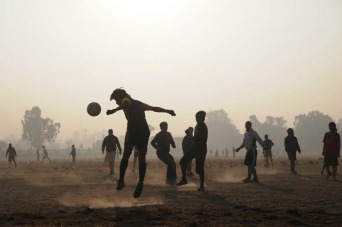The World's Game

Villagers play early morning soccer in Nepal
Of all the sports in the world, soccer is perhaps unique in that it requires virtually no equipment to play. As evidenced by the presence of soccer games in even the poorest corners of the poorest nations of the world, all one needs is a round object to act as a ball and enough players to field two squads. While it is true that most leagues in developed countries mandate such equipment as shinguards, spikes, and uniforms--all of which can be expensive--these items are not necessary to play the game. Even formal goals with nets are not require to play a soccer match, as any two objects spread a fair distance apart will act suitably. Thus is it possible for even the poorest of the poor to participate in soccer matches, and this is often evidenced by pickup games played in the streets, in dirt fields, in abandoned lots, and just about everywhere in between.
Another advantage that soccer enjoys is that its rules and regulations are fairly simple easy to understand, and are thus highly conducive to being understood and adopted by a wide variety of people. The object of the game is quite basic: get the ball into your opponents goal without using your hands. This simplicity makes soccer incredibly easy for newcomers to pick up and follow. Even the formal rules established by FIFA are relatively uncomplicated, as they are wholly encompassed in a set of 17 Laws of the Game, which have remained largely unchanged for much of soccer's history. Indeed, this simplicity and easy of understanding is one of the primary driving forces behind soccer's rise to its position as the world's most popular game, at least according to Eric Dunning. Dunning, a professor of sociology at the University of Leicester in the United Kingdom, writes in his book Sport Matters that,
"The reasons for [soccer's] comparative success are not difficult to find. It does not require much equipment and it is comparatively cheap to play. It's rules--apart from perhaps the offside law--are relatively easy to understand. Above all, the these rules regularly make for fast, open and fluid play, and for a game which is fiercely balanced among a number of interdependent polarities such as force and skill, individual and team play, attack and defense. As such, its structures permit the recurrent generation of levels of excitement which are satisfying for players and spectators alike" (1).
"The reasons for [soccer's] comparative success are not difficult to find. It does not require much equipment and it is comparatively cheap to play. It's rules--apart from perhaps the offside law--are relatively easy to understand. Above all, the these rules regularly make for fast, open and fluid play, and for a game which is fiercely balanced among a number of interdependent polarities such as force and skill, individual and team play, attack and defense. As such, its structures permit the recurrent generation of levels of excitement which are satisfying for players and spectators alike" (1).
Dunning also references another quality of soccer that has led to its dominance across the globe, and that is that soccer can be played (and played competitively) by people of all shapes and sizes. Unlike basketball, where above average height is essentially a prerequisite for success, or rugby, where a muscular build is necessary merely to avoid being killed, soccer is a game in which the average height, weight, and muscle composition of a player can vary greatly. Scientists have noted that, "Professional players do vary in weight and size especially when ethnic influences are taken into account. For example, data on international Asian teams demonstrated that their players were smaller in physical size, especially when compared to European teams," as well as that, "Upper body strength in professional players would be expected to be higher than that of others. However previous studies have shown this is not the case" (2). This combination of evidence suggests that the biological requirements to play soccer and to succeed at it are not as pronounced as in other sports, which makes soccer appealing to a wider audience of prospective players. What is clear is that a person's biological makeup does not determine whether he is able to play soccer proficiently or not, as any physical disadvantage can be overcome through practice and hard work. The scientists quoted previously drew a similar conclusion from the results of their study, as they stated that, "Even in the elite game, individuals who demonstrate a weakness in one of these physiological factors, can often compensate through an excellent reading of the game as well as a highly developed technique" (2).
(1) Eric Dunning. "The Development of Soccer as a World Game." Sport Matters: Sociological Studies of Sport, Violence, and Civilization. Taylor & Francis, 1999. Pg. 103-105.
(2) "The Professional Game--Physiological Profiles." http://www.soccerperformance.org/playertypes/physprofilesprosoccer.htm.
(1) Eric Dunning. "The Development of Soccer as a World Game." Sport Matters: Sociological Studies of Sport, Violence, and Civilization. Taylor & Francis, 1999. Pg. 103-105.
(2) "The Professional Game--Physiological Profiles." http://www.soccerperformance.org/playertypes/physprofilesprosoccer.htm.
